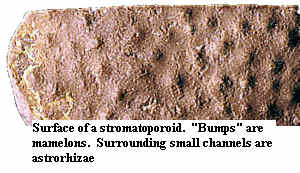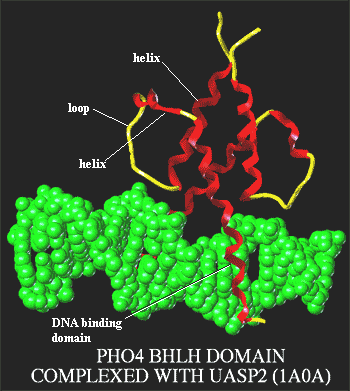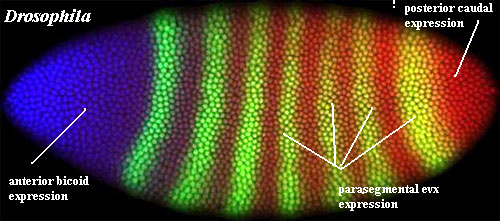
All material by ATW may be used under the terms of a
Public Domain Dedication.
| Glossary | ||
| Metazoa | Glossary A-B |
| Metazoa | |||||
| Life | Time |
|
Life
├─Eubacteria
└─┬─Archaea
└─Eukarya
├─Chlorobionta
└─┬─Fungi
└─Metazoa
├─Choanoflagellata
└─Porifera
├─Radiata
└─┬─Cnidaria
└─Bilateria
├─Deuterostomia
└─Protostomia
├─Ecdysozoa
└─Spiralia
|
The eventual aim is to combine all the glossaries distributed throughout the metazoan section. This will takes many years. |
Numerical |
Drosophila |
Abbreviation |
Notes |
|---|---|---|---|
Hox1 |
labial |
lab |
Beginning of anterior class and ANTP complex in Drosophila |
Hox2 |
proboscipedia |
pb |
|
Hox3 |
(Zerknüllt, Bicoid) |
(zen, bcd) |
Hox3 class. Hox3 is probably its own "upper middle class" homology group. Drosophila has two Hox3 homologues, but neither is homeotic. |
Hox4 |
Deformed |
Dfd |
Beginning of middle class |
Hox5 |
Sex combs reduced |
Scr |
Insects have a "hox 5½," fushi tarazu (ftz), which is not homeotic |
Hox6 |
Antennapedia |
Antp |
Hox6-8 are homologues of Antp,Ubx and AbdA as a group. That is, all 6 and ftz) derive from a single "lower middle class" gene in Urbilateria. |
Hox7 |
Ultrabithorax |
Ubx |
Beginning of UBX complex in Drosophila |
Hox8 |
Abdominal A |
AbdA |
|
Hox9 |
Abdominal B |
AbdB |
Beginning of posterior class |
Hox10, 11 ... |
No arthropod homologues -- or (more exactly) AbdB is homologous to all posterior hox. |
abdominal-A a gene, abbreviated abdA, a middle class hox gene of arthropods. See Hox Genes.
abdominal-B a gene, abbreviated abdB, the posterior class hox gene of arthropods. See Hox Genes.
acron (arthropod anatomy) the most anterior region of the body. The acron may or may not be a segment. It contains the protocerebrum and the eyes (ocelli and compound eyes). The jury is still out on the existence, identity, and homologies of any appendages.
acrosome an anterior structure of animal spermatozoa. The acrosome is functionally similar to the warhead of an armor-piercing artillery shell and assists in fertilization. The acrosome reaction actually seems to involve three related steps: (1) it assists the spermatozoon to cut a channel through the layer of glycoprotein surrounding the egg; (2) the membrane surrounding the acrosome fuses with the egg's plasma membrane; and (3) since the acrosome membrane is continuous with the nuclear membrane, presumably promotes insertion of the sperm's nucleus. The acrosome is a modified Golgi apparatus. See Acrosome Reaction for more details and link to an animation.
amoebocyte (general cell biology), any of various types of amoeboid, generally undifferentiated cells which frequently function as a stem cell lineage for several different types of differentiated tissues.
anamorphic crustacean embryology. Developmental program in which a nauplius larva develops to adult state through a series of incremental changes involving the addition of posterior segments and appendages.
ANT-C see antennapedia.
antenna in Crustacea, this can either refer to any of the four anterior head appendages, or just to the second pair. The second antennae tend to be flattened and more laterally placed. Modifications of the antennae are relatively common in crustaceans. For example, the second antennae are also frequently modified to act as chemosensory organs or copulatory claspers.

Antennapedia genetics. (1) Antennapedia gene: a homeobox gene (abbreviated Antp or Atpa) the middle class (hox6-8) of vertebrates (2) The Antennapedia Complex: (Deformed (Def or Dfd), Sex combs reduced (Scr), fushi tarazu (ftz), and Antennapedia, in that order (although, naturally, not all of these elements are present in all metazoans). The other major complex of hox genes is the Bithorax Complex (BX-C), the component genes of which are expressed in the more posterior parts of the developing organism. (3a) Antennapedia class: Finally, just to make things more complicated, note that the genes which are most closely related to Atpa by sequence (and the structure of the proteins they ultimately encode) are not all located in the Antennapedia complex. Thus the Antennapedia class (not "complex") includes genes of all major Bithorax Complex genes, including ultrabithorax ubx), for which the complex is named. (3b) Other authors apparently use "antennapedia class" to mean something much broader. We have not yet been able to determine the contours of this usage.
antennule first antenna of a crustacean. These tend to be longer then the second antennae and to function as tactile organs, like the whiskers of a cat, but more so.
antp see antennapedia.
aragonite One of the two common polymorphs chanically identical, alternate crystal forms) of calcium carbonate, CaCO3. The other common polymorph is calcite. Aragonite tends to form in environments with higher magnesium concentration although, unlike calcite, it cannot incorporate megnesium into the crystal. Aragonite is less stable than calcite and tends to recrystalize as calcite within a few million years. Aragonite crystals are also typically smaller than calcite crystals and often have a needle-like form.

armature crustacean anatomy, a collective term for the entire battery of spines, setae, and other projections from an appendage which don't rate a special name as limb elements or gills.
arthro- in anatomy, a prefix suggesting that a structure is related to a joint.
astrorhizae a pattern of channels on the surface of a sponge (stromatoporoid), believed to contain the exhalent pores.
atrium (general anatomy) a common term referring to any of hundreds of types of large, internal anatomical spaces.
axoneme the fundamental 9+2 doublet microtubule structure at the core of the eukaryotic flagellum. The axoneme arises from the basal body and inserts into the axosome.

basement membrane "Basement membranes are sheet-like complexes of extracellular matrix proteins, highly structured and containing specifically type IV collagen as scaffold. They underlie epithelial, endothelial tissues, most glial cells and they surround several mesenchymal cells and especially all the muscle cell types. Basement membranes exert not only a mechanical function as supporting structures, but they also play a major biological role as molecular sieves and in the control of cell differentiation and stability." Boute et al. (1996).
basic helix-loop-helix bHLH) another diverse and important DNA-binding protein motif, including many transcription factors, not to be confused with helix-turn-helix. They have been described as follows: "The bHLH transcription factors are named after their highly conserved domain (about 60 amino acids long) that consists of a DNA-binding basic region b) followed by two α-helices separated by a variable loop region. Interaction between the helix regions of two different proteins leads to the formation of homodimeric or heterodimeric complexes, and the basic region of each partner recognizes and binds to a core hexanucleotide DNA sequence. Many bHLH proteins also include additional domains that are important for their activity as transcriptional regulators, such as 'leucine zipper', 'PAS' or 'orange' domains, which are mainly involved in protein-protein interactions." Simonionato et al. (2007).
basis the second segment of a crustacean appendage. See image at protopod. See Dr. Joel Martin's Crustacea Glossary for details and exceptions.
bauplän pl. baupläne. See body plan.
benthic bottom-living, i.e. living on the sea floor.

biramous having two "stems" or long axes. Tends to be used for any long structure which bifurcates. The biramous limb has special significance in the Crustacea. See endopod for explanation and complaints.
body plan: The concept of a body plan, Bauplän (pl. Baupläne), is critical to understanding the most fundamental evolutionary radiations. What is a body plan? This is a difficult question to define, and it is usually answered with examples: the insect body plan, the jellyfish body plan, or whale body plan. Loosely defined, a body plan is primarily morphological, involving the shared structural homologies of upper taxa. For example, the vertebrate bauplän might be described as comprising a "cephalised, sensate, bilaterally symmetrical, motile, ceolomate gnathostome having a segmented endoskeleton, a dorsal hollow nerve chord, and a ventral gut." Ostrom 1992: 119). Body plans reflect development at its most basic level, thus developmental constraints strongly influence the range of body plans possible. Even in simple animals, axes of symmetry are so fundamental that significant internal co-adaptation is required for viable body plan mutations to occur. This raises the question of why a number of different body plans arose at the cusp of the Cambrian Period – the so-called Cambrian Explosion. Some paleobiologists believe the answer lies in the Ediacaran fossil remains dating back before the Cambrian, in the Ediacaran Period (630-542 million years ago).
branch- or -branch a prefix, suffix, or particle intended to suggest that an organism or structure has or is a gill. MAK010510.
Burgess Shale Middle Cambrian of British Columbia, Canada. The Burgess Shale fauna is preserved in the deep water Stephens Formation. However it probably represents organisms swept off a shallower carbonate escarpment formed by the adjacent Cathedral Formation and rapidly buried by some catastrophic event, i.e. storm, marine landslide, loss of grant funding, etc.
Page by: ATW070128
Last revised: ATW070805
Checked ATW070725